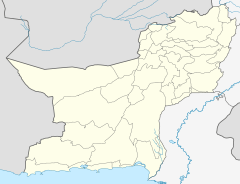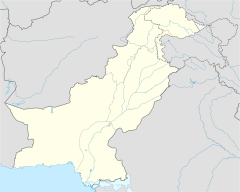Panjgur facts for kids
Quick facts for kids
Panjgur
پنجگور
Not known.
|
|
|---|---|
|
District Headquarters
|
|
| Country | Pakistan |
| Province | Balochistan Province |
| District | Panjgur District |
| Elevation | 980 m (3,220 ft) |
| Population
(2023)
|
|
| • City | 157,693 |
| Time zone | UTC+5 (PST) |
Panjgur is a town in the Panjgur District of Balochistan, Pakistan. It is very famous for its delicious dates. The name "Panjgur" comes from two Balochi words. "Panj" means five, and "Goran" means highland. So, Panjgur means "land of five highlands."
This town is about 980 meters (3,215 feet) above sea level. It is the only high area in the Makran region. Some people think "Goran" might come from an old word meaning mountain. There are also nearby places like Chokgoran ("small highland") and Mazangoran ("big highland"). This suggests the name "Goran" has a shared origin. Another idea is that Panjgur means "five graves."
Panjgur District is a major area for growing Mazafati or Muzati dates. These are a very high-quality type of date. About 27,000 acres of land in Panjgur are used to grow Muzati dates. These dates bring in about 10% of Panjgur's total income.
History of Panjgur
In 985 AD, a writer named Al-Muqaddasī wrote about Panjgur. He called it Bannajbur. He said it was the capital city of Makran. He also noted that people called Balūṣh (Baluch) lived there. This is one of the first times the Baloch people were mentioned in Arabic writings.
Panjgur's Climate
Panjgur has a hot desert climate. This means it has very hot summers. However, it is milder and cooler than other parts of the Makran region. Winters in Panjgur are cold, windy, and dry.
Most of the rain falls during two main times of the year. One period is in mid-winter and early spring, from late December to March. The other is during the monsoon season, in June and July.
| Climate data for Panjgur | |||||||||||||
|---|---|---|---|---|---|---|---|---|---|---|---|---|---|
| Month | Jan | Feb | Mar | Apr | May | Jun | Jul | Aug | Sep | Oct | Nov | Dec | Year |
| Record high °C (°F) | 26.7 (80.1) |
29.4 (84.9) |
34.5 (94.1) |
39.0 (102.2) |
44.4 (111.9) |
45.0 (113.0) |
45.0 (113.0) |
43.3 (109.9) |
41.5 (106.7) |
38.0 (100.4) |
34.0 (93.2) |
29.0 (84.2) |
45.0 (113.0) |
| Mean daily maximum °C (°F) | 17.4 (63.3) |
19.8 (67.6) |
25.6 (78.1) |
31.2 (88.2) |
36.3 (97.3) |
39.4 (102.9) |
38.8 (101.8) |
38.1 (100.6) |
35.4 (95.7) |
30.7 (87.3) |
24.8 (76.6) |
19.5 (67.1) |
29.8 (85.5) |
| Daily mean °C (°F) | 10.5 (50.9) |
12.8 (55.0) |
18.2 (64.8) |
23.7 (74.7) |
28.5 (83.3) |
31.7 (89.1) |
31.7 (89.1) |
30.7 (87.3) |
27.2 (81.0) |
22.1 (71.8) |
16.6 (61.9) |
12.1 (53.8) |
22.1 (71.9) |
| Mean daily minimum °C (°F) | 3.7 (38.7) |
5.7 (42.3) |
10.9 (51.6) |
16.1 (61.0) |
20.7 (69.3) |
24.0 (75.2) |
24.7 (76.5) |
23.3 (73.9) |
19.0 (66.2) |
13.6 (56.5) |
8.4 (47.1) |
4.6 (40.3) |
14.6 (58.2) |
| Record low °C (°F) | −6.7 (19.9) |
−4.4 (24.1) |
0.0 (32.0) |
5.0 (41.0) |
5.5 (41.9) |
13.5 (56.3) |
13.9 (57.0) |
13.9 (57.0) |
8.9 (48.0) |
3.0 (37.4) |
−3.3 (26.1) |
−7.8 (18.0) |
−7.8 (18.0) |
| Average precipitation mm (inches) | 16.3 (0.64) |
16.2 (0.64) |
15.6 (0.61) |
7.4 (0.29) |
3.1 (0.12) |
3.3 (0.13) |
25.0 (0.98) |
9.2 (0.36) |
1.5 (0.06) |
0.8 (0.03) |
0.8 (0.03) |
9.5 (0.37) |
108.7 (4.26) |
| Source: NOAA (1961-1990) | |||||||||||||
People and Religions in Panjgur
The table below shows the different religious groups living in Panjgur City. It compares numbers from 1941 to 2017. You can see how the population has grown and changed over time.
| Religious group |
1941 | 2017 | ||
|---|---|---|---|---|
| Pop. | % | Pop. | % | |
| Islam |
416 | 87.95% | 80,273 | 99.83% |
| Hinduism |
45 | 9.51% | 96 | 0.12% |
| Sikhism |
9 | 1.9% | N/A | N/A |
| Christianity |
3 | 0.63% | 42 | 0.05% |
| Total population | 473 | 100% | 80,411 | 100% |
Areas within Panjgur
Panjgur is divided into smaller areas, like neighborhoods or sections. The three main modern parts of Panjgur are Gramkān, Qila Khudābadān, and Tasp. In the past, people used to say Panjgur had 12 parts. That's why it was sometimes called Dwazdah Shahr e Panjgur, which means "12 Towns of Panjgur."



